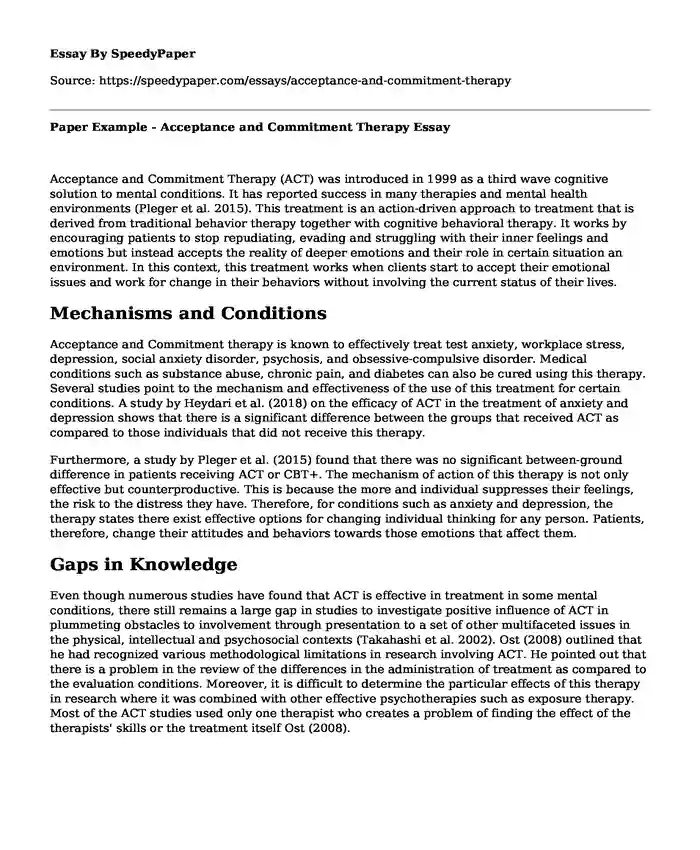
| Type of paper: | Essay |
| Categories: | Stress Mental health Psychological disorder Behavior change |
| Pages: | 3 |
| Wordcount: | 657 words |
Acceptance and Commitment Therapy (ACT) was introduced in 1999 as a third wave cognitive solution to mental conditions. It has reported success in many therapies and mental health environments (Pleger et al. 2015). This treatment is an action-driven approach to treatment that is derived from traditional behavior therapy together with cognitive behavioral therapy. It works by encouraging patients to stop repudiating, evading and struggling with their inner feelings and emotions but instead accepts the reality of deeper emotions and their role in certain situation an environment. In this context, this treatment works when clients start to accept their emotional issues and work for change in their behaviors without involving the current status of their lives.
Mechanisms and Conditions
Acceptance and Commitment therapy is known to effectively treat test anxiety, workplace stress, depression, social anxiety disorder, psychosis, and obsessive-compulsive disorder. Medical conditions such as substance abuse, chronic pain, and diabetes can also be cured using this therapy. Several studies point to the mechanism and effectiveness of the use of this treatment for certain conditions. A study by Heydari et al. (2018) on the efficacy of ACT in the treatment of anxiety and depression shows that there is a significant difference between the groups that received ACT as compared to those individuals that did not receive this therapy.
Furthermore, a study by Pleger et al. (2015) found that there was no significant between-ground difference in patients receiving ACT or CBT+. The mechanism of action of this therapy is not only effective but counterproductive. This is because the more and individual suppresses their feelings, the risk to the distress they have. Therefore, for conditions such as anxiety and depression, the therapy states there exist effective options for changing individual thinking for any person. Patients, therefore, change their attitudes and behaviors towards those emotions that affect them.
Gaps in Knowledge
Even though numerous studies have found that ACT is effective in treatment in some mental conditions, there still remains a large gap in studies to investigate positive influence of ACT in plummeting obstacles to involvement through presentation to a set of other multifaceted issues in the physical, intellectual and psychosocial contexts (Takahashi et al. 2002). Ost (2008) outlined that he had recognized various methodological limitations in research involving ACT. He pointed out that there is a problem in the review of the differences in the administration of treatment as compared to the evaluation conditions. Moreover, it is difficult to determine the particular effects of this therapy in research where it was combined with other effective psychotherapies such as exposure therapy. Most of the ACT studies used only one therapist who creates a problem of finding the effect of the therapists' skills or the treatment itself Ost (2008).
Control Group
The control group for this research is the group of individuals that are separated from the rest of the experiment. In this case, individuals that are given CBT as a therapy for the treatment of anxiety and depression occupy this position. The differences between the two treatments are that CBT uses faulty thinking that is correct by learning while ACT uses mixed acceptance techniques that change behaviors in a patient. Therefore, CBT treatment is extensive and can cover more individuals while ACT is limited to a few individuals.
References
Heydari, M., Masafi, S., Jafari, M., Saadat, S. H., & Shahyad, S. (2018). Effectiveness of Acceptance and Commitment Therapy on Anxiety and Depression of Razi Psychiatric Center Staff. Open access Macedonian journal of medical sciences, 6(2), 410-415.doi:10.3889/oamjms.2018.064
M. Pleger, K. Treppner, A. Diefenbacher, C. Schade, C. Dambacher & T. Fydrich. Effectiveness of Acceptance and Commitment Therapy compared to CBT+: Preliminary results. The European Journal of Psychiatry. Volume 32, Issue 4, 2018, Pages 166-173, ISSN 02136163, https://doi.org/10.1016/j.ejpsy.2018.03.003.
Takahashi, M., Muto, T., Tada, M. and Sugiyama, M. (2002) Acceptance Rationale andIncreasing Pain Tolerance: Acceptance-Based and FEAR-Based Practice. Japanese Journal of Behavior Therapy, 28, 35-46.
Ost, L.G. (2008). Efficacy of the third wave of behavioral therapies: A systematic review Meta-analysis. Behaviour Research and Therapy, 46, 296-321.
Cite this page
Paper Example - Acceptance and Commitment Therapy. (2023, Jan 09). Retrieved from https://speedypaper.net/essays/acceptance-and-commitment-therapy
Request Removal
If you are the original author of this essay and no longer wish to have it published on the SpeedyPaper website, please click below to request its removal:
- Gothic Architecture Characteristics
- Free Essay on Education Goals - Electrical Engineering College
- Free Essay Sample on American Red Cross
- A Journey Through the Old Testament, Essay Sample with the Book Review
- Free Essay for Students: Listening
- Essay Example: The Concept of Power, Class, Hegemony, Negotiation, And Desire
- The Health Effects of Smoking Cessation - Essay Example
Popular categories




